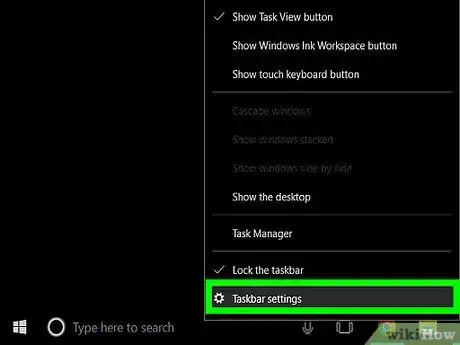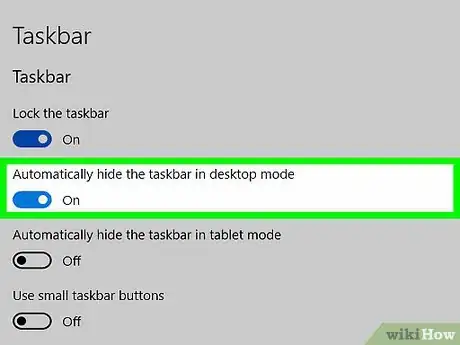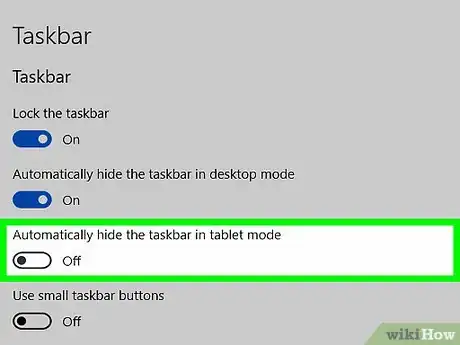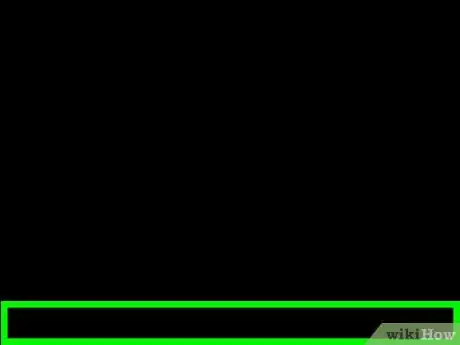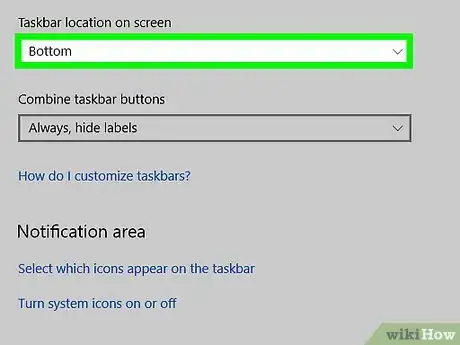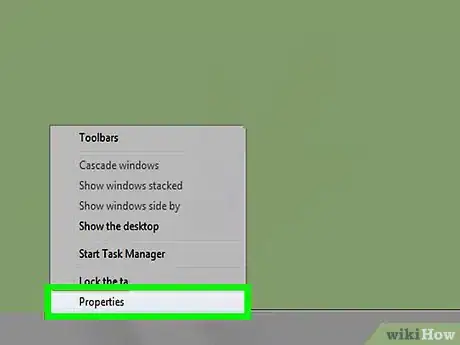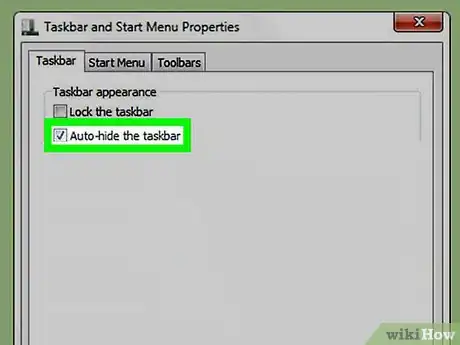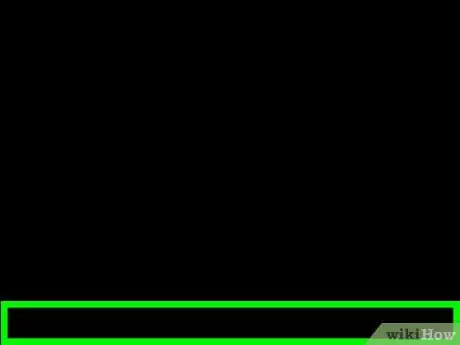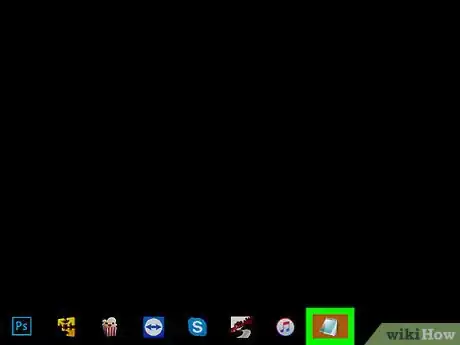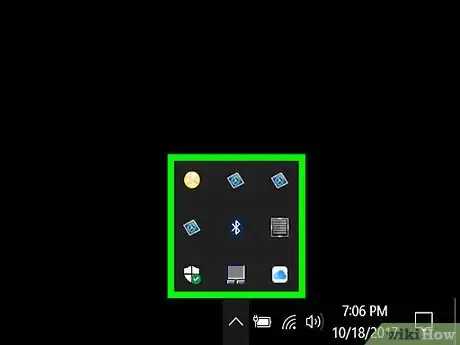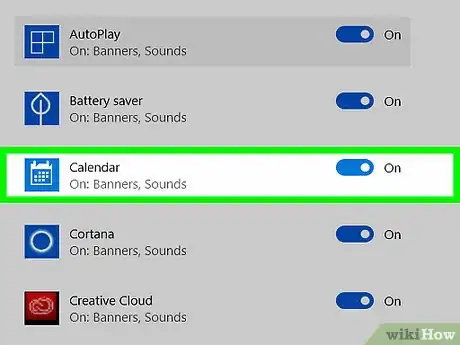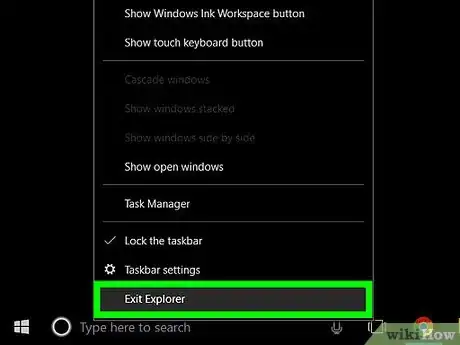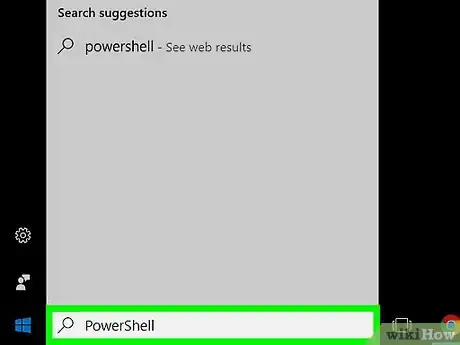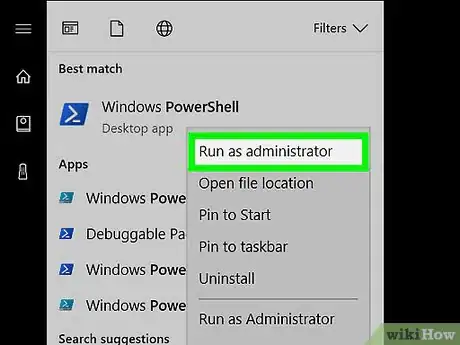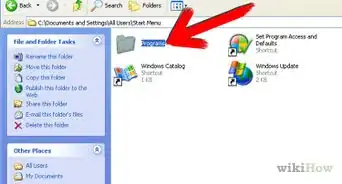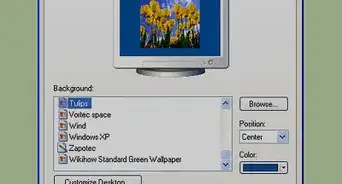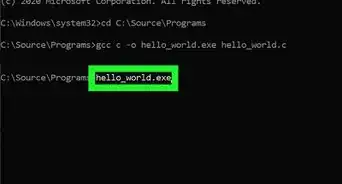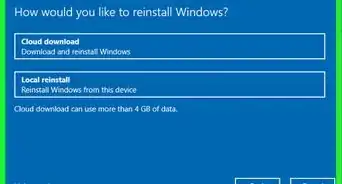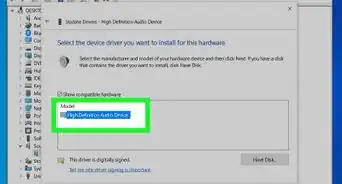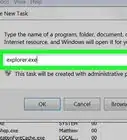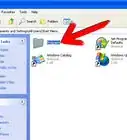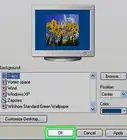This article was co-authored by wikiHow Staff. Our trained team of editors and researchers validate articles for accuracy and comprehensiveness. wikiHow's Content Management Team carefully monitors the work from our editorial staff to ensure that each article is backed by trusted research and meets our high quality standards.
The wikiHow Tech Team also followed the article's instructions and verified that they work.
This article has been viewed 568,373 times.
Learn more...
Hiding the Windows taskbar when you're not using it can give you more space on your screen and show off your desktop backgrounds. You can hide the taskbar from the Settings menu in Windows 10, or from the taskbar Properties window in older versions. If your taskbar won't go away or stay hidden, there are a few things you can try.
Steps
Hiding the Taskbar on Windows 10
-
1Right-click on the taskbar and select "Taskbar settings". Make sure you right-click on a blank space, and not on an icon. To right-click on a touchscreen, press and hold the taskbar for a few moments, then release to open the right-click menu.
- You can also open the Start menu, select "Settings," tap or click "Personalization," and then select "Taskbar" in the left menu.
- If you right-click and see "Properties" instead of "Settings," you're running an outdated version of Windows 10. You can follow the instructions in the next section to hide the taskbar.
-
2Toggle "Automatically hide the taskbar in desktop mode" on. The taskbar will hide immediately. This will affect the taskbar whenever your computer is in desktop mode. If your computer is not a tablet, this is the only setting you need to worry about.Advertisement
-
3Toggle "Automatically hide the taskbar in tablet mode" on. This will hide the taskbar if your device is in tablet mode. You can switch to tablet mode by tapping the Notifications button in the lower-right corner of the desktop, and then tapping the "tablet mode" button.
-
4Open the taskbar by moving your mouse to the bottom of the screen. When you place your cursor at the bottom of the screen, the taskbar will appear. It will hide again after you move your cursor off it.
- If you're using a tablet, you can show the taskbar by swiping up from the bottom of the screen.
-
5Change the location of the taskbar. You can use the "Taskbar location on screen" menu to change where the taskbar appears. You may find it more useful to have it along one of the sides, or at the top of the screen. The change will take place immediately.
Hiding the Taskbar on Windows 8, 7, and Vista
-
1Right-click the taskbar and select "Properties." If you're using Windows 8, select "Desktop" from the Start menu or press ⊞ Win+D first to open the desktop view.
-
2Check the "Auto-hide the taskbar" box. You'll find this in the "Taskbar" tab.
-
3Click "Apply." You'll see the taskbar disappear. You can click "OK" to close the menu, or adjust further settings.
-
4Reveal the taskbar with your mouse cursor. Move your cursor to the bottom of the screen and the taskbar will pop back up. It will hide again when you move your mouse off it.
Troubleshooting
-
1Check for programs keeping the taskbar open. If a program is flashing in the taskbar, it won't close. Clicking the flashing program will switch to the program and stop it from trying to notify you.
-
2Check the icons in your system tray. The system tray can be found in the lower-right corner of the screen, next to the clock. Like the programs in your taskbar, icons in your system tray may be keeping the taskbar open when trying to notify you. Click the icon with the notification to see what the program needs.[1]
- The program icon may be hidden. Click the arrow to the left of the row of icons to see any hidden icons.
-
3Disable notifications for specific programs. If you're constantly having to dismiss notifications, or if a notification won't go away and the taskbar is stuck on, you can try disabling all notifications.[2]
- Windows 10 - Click the Start menu and select "Settings." Select "System" and then "Notifications & actions." Toggle the notifications off for specific apps, or toggle them all off at the top of the list.
- Windows 8, 7, and Vista - Click the Expand arrow next to your system tray icons, then click "Customize." Find the app you want to disable notifications for and select "Hide icon and notifications."
-
4Try reapplying the settings. Sometimes toggling the auto-hide feature off and the on again will fix a taskbar that won't go away. Open the Settings (Windows 10) or Properties window again and turn the auto-hide feature off. Click "Apply" in Windows 8 and earlier versions. Once you've turned it off, toggle it back on again and apply the settings.
-
5Reset Windows Explorer. This is the user interface for Windows, and resetting it may fix your taskbar issues.[3]
- Hold Ctrl+⇧ Shift and right-click the taskbar.
- Select "Exit Explorer" from the menu. Your taskbar and all of your icons and folders will disappear.
- Press Ctrl+⇧ Shift+Esc to open the Task Manager.
- Click "File" → "Run new task."
- Type "explorer" and press ↵ Enter. This will reload explorer.
Troubleshooting Windows 10
-
1Press .⊞ Win+R and type "powershell" to open PowerShell. If you're using Windows 10 and the taskbar won't stay hidden, you can try using the PowerShell utility to fix it.
-
2Right-click the PowerShell icon in your taskbar and select "Run as administrator." Confirm that you want to proceed. This will open a new "Administrator" PowerShell window.
-
3Copy and paste the following command. Make sure you paste it into the "Administrator" window:
- Get-AppXPackage -AllUsers | Foreach {Add-AppxPackage -DisableDevelopmentMode -Register "$($_.InstallLocation)\AppXManifest.xml"}
-
4Run the command. You may see a few errors as the command runs, which can safely be ignored.
-
5Click or tap the Start menu after the command finishes. You should notice that the taskbar hides as it should and stays hidden.[4]
Community Q&A
-
QuestionHow do I get rid of the space at the top of my screen where the taskbar used to be?
 Community AnswerIf there is a blank white or colored space after your taskbar tucks itself away, it is likely a glitch, so you should restart your device.
Community AnswerIf there is a blank white or colored space after your taskbar tucks itself away, it is likely a glitch, so you should restart your device. -
QuestionHow can I make my taskbar disappear when it is in the way?
 Community AnswerRight click the taskbar and choose "Properties". In the menu that opens, click the option that says "Auto-hide the taskbar". This will cause the taskbar to disappear until you mouse over where it is on the screen.
Community AnswerRight click the taskbar and choose "Properties". In the menu that opens, click the option that says "Auto-hide the taskbar". This will cause the taskbar to disappear until you mouse over where it is on the screen. -
QuestionWhy does the task bar remain visible even with the hide button selected?
 Community AnswerIf there is some sort of "urgent" pop-up, like another application, open and re-minimize your current tasks. If this does not work, look toward the left side of the task bar. There should be a little arrow to expand. Click it, and check if there is anything there. It most likely will be that Java needs to be updated.
Community AnswerIf there is some sort of "urgent" pop-up, like another application, open and re-minimize your current tasks. If this does not work, look toward the left side of the task bar. There should be a little arrow to expand. Click it, and check if there is anything there. It most likely will be that Java needs to be updated.
References
- ↑ http://www.thewindowsclub.com/auto-hide-taskbar-windows
- ↑ https://steamcommunity.com/app/331670/discussions/0/610573567803866129/
- ↑ http://www.howtogeek.com/howto/31779/fixing-when-the-windows-taskbar-refuses-to-auto-hide-correctly/
- ↑ http://answers.microsoft.com/en-us/windows/forum/windows_10-start/windows-10-taskbar-wont-auto-hide/aa955b06-0bc4-4665-b292-bcb9bb2907bd?auth=1
